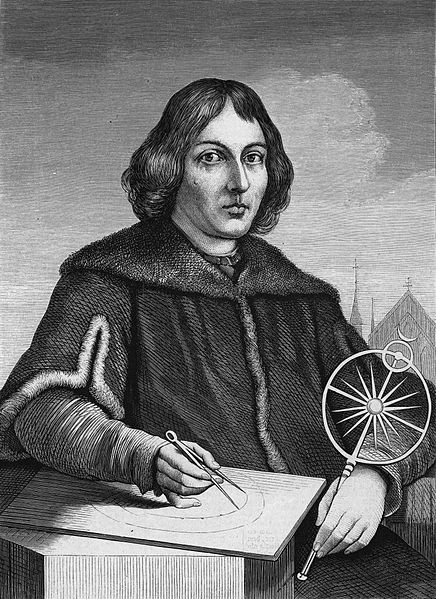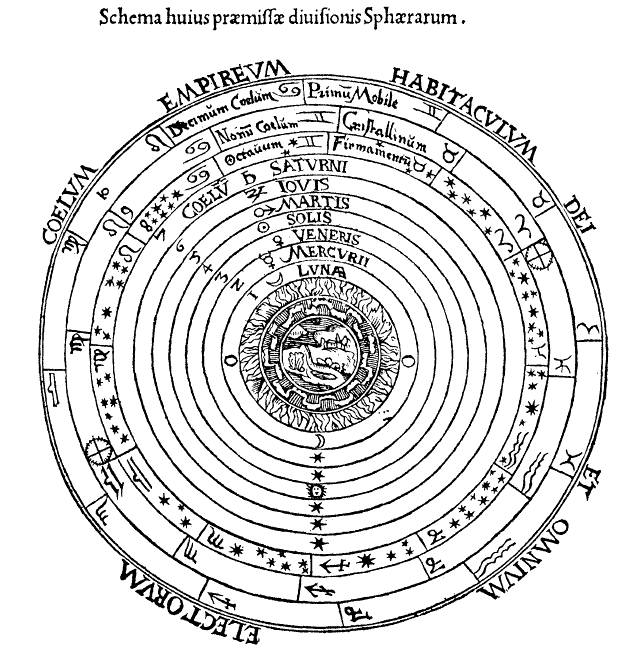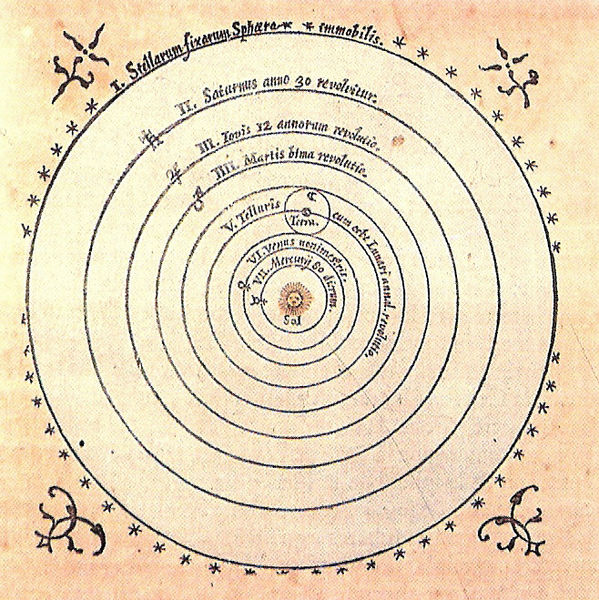Perhaps there will be babblers who claim to be judges of astronomy although completely ignorant of the subject and, badly distorting some passage of Scripture to their purpose, will dare to find fault with my undertaking and censure it. I disregard them even to the extent of despising their criticism as unfounded.
Copernicus, De revolutionibus orbium coelestium
Even though he probably accepted a fairly young cosmos—the only option available in the 16th century—Nicolaus Copernicus was far too sophisticated a thinker to have been a friend of 21st century biblical literalists. W ere he alive today, the Roman Catholic astronomer would no doubt give short shrift to any fundamentalist who insisted on constraining science by the prescientific dictates of the Bible. He understood perfectly well the medieval Church’s careful distinction between literal and figurative meanings of scripture.
ere he alive today, the Roman Catholic astronomer would no doubt give short shrift to any fundamentalist who insisted on constraining science by the prescientific dictates of the Bible. He understood perfectly well the medieval Church’s careful distinction between literal and figurative meanings of scripture.
We celebrated Copernicus’ 541st birthday on February 19th, remembering that his work helped ignite a movement that eventually brought us evolution and the Big Bang, gene splicing and the Internet. Copernicus’ De revolutionibus orbium coelestium (On the Revolutions of the Heavenly Spheres) ushered in sweeping changes in scientific methodology and understanding that led to what we know as the “Scientific Revolution.” Following Copernicus, the work of many scientists—people such as Galileo and Kepler and Newton, Vesalius and Harvey, Boyle and Hutton, Lyell and Darwin—revised our picture not only of the size and age of the cosmos, but also of anatomy and physiology, of natural history and the age of the earth, of psychology and the nature of the human person.
Born in Torún, Poland, in 1473, Copernicus was a conscientious churchman, an avid observer of the heavens, and a cautious reformer of received astronomical tradition. (Biographical details in this post are drawn from my article on Copernicus in Macmillan's Encyclopedia of Science and Religion.) In 1491 he matriculated in the famous Jagiellonian University of Cracow, an institution strong in mathematics and proud of its endowed chair of astronomy dating from 1410. Copernicus’ study of the theories of such luminaries as Ptolemy, Euclid, Sacrobosco and Regiomontanus was complemented by his own observation in Cracow of the comets of 1491 and 1492, and of four lunar and solar eclipses during the next two years. Following his studies in Italy he returned to Poland in 1503 to embark upon his duties as a canon of Frombork Cathedral. For the next four decades he was engaged in administration of the diocese, maintaining his passion for astronomy by constructing a modest observatory in a tower near the cathedral. Copernicus completed his life’s work—De revolutionibus orbium coelestium—just weeks before his death in 1543.
On the Revolutions of the Heavenly Spheres initiated a profound process of revision of the cosmos that continues today. Copernicus’ enduring legacy was his rehabilitation of the long-neglected heliocentric hypothesis, first proposed in the third century BCE by Aristarchus of Samos and later discussed by Archimedes. The ancient arguments against heliocentrism―both from common sense and from lack of observed stellar parallax―had been so overwhelming that the alternative geocentric cosmology prevailed from antiquity throughout the later Middle Ages. Aristotle envisioned a set of nested concentric spheres bearing the planets, the sun, the moon and the stars around a spherical, stationary Earth.
This system was enlarged and codified by the second century Alexandrian astronomer Claudius Ptolemy in his Almagest, which became the basic astronomical text of the scholastic canon. Ptolemaic astronomy was integrated with Aristotelian physics, in which circular motion was proper to the heavens and rectilinear motion to the earth. The pre-Copernican cosmology was in turn integrated with theology to form an orderly scholastic synthesis of physics, astronomy, and theology. In contrast to how modern science o perates, each science in the scholastic hierarchy of disciplines operated from its own set of principles. Together they governed everything from the nature of matter and planetary motion to the geographic location of heaven and hell.
perates, each science in the scholastic hierarchy of disciplines operated from its own set of principles. Together they governed everything from the nature of matter and planetary motion to the geographic location of heaven and hell.
By the sixteenth century Ptolemaic astronomy had begun to encounter difficulties in accurately predicting celestial phenomena. When compounded annually over more than a millennium, the minute inaccuracies of this system had pushed astronomical reckoning off by ten days. This cumulative error posed serious calendrical problems, including the difficulty of correctly calculating the date of Easter, the central Christian feast on which much of the church year and its religious practices were based. Astronomy was therefore definitely relevant to matters pertaining to the salvation of souls, and it was in this context that Copernicus pursued his quest to improve predictive accuracy in astronomy.
Copernicus gradually turned his attention to the possibility of a moving earth, sketching his system in his Commentariolus that circulated widely before 1514. Copernicus challenged established tradition by proposing three kinds of terrestrial motion: diurnal rotation of the earth, annual revolution about the stationary sun, and motion in declination to account for the precession of the equinoxes. Copernicus continued to elaborate his planetary theory during the next quarter century.
Copernicus’s deceptively simple insight in De revolutionibus carried with it enormous implications for a wide range of disciplines and questions. In physics and astronomy, it played an important role in initiating the process of scientific discovery that has led from Kepler and Galileo through Newton and Laplace to the present time. In epistemology, the Copernican revolution upset the established order of the scholastic curriculum by daring to use mathematics, a “lower” science, to correct astronomy, a science of higher dignity. An extension of this epistemological challenge was Galileo’s elevation of sense experience—in the form of experiment and observation— into a more important role than it had enjoyed under the Aristotelian natural philosophy of medieval scholasticism.
Galileo’s elevation of sense experience—in the form of experiment and observation— into a more important role than it had enjoyed under the Aristotelian natural philosophy of medieval scholasticism.
Copernicus and his successors also contributed to the secularization of modernity by removing the Earth from its central location, and the relativization of human concerns among the infinities of time and space. Copernicus himself contended that the size of the universe was “similar to the infinite.” What did all this mean for Christian theology?
In the last four centuries we can see an intriguing swing from the Church’s relative neutrality on cosmology before Copernicus, to its rigid adherence to the Aristotelian-Ptolemaic worldview during the Galileo affair, and back again to a relative independence from cosmological commitment today. It was Catholic priest Georges Lemaître who proposed Big Bang cosmology in 1927.
The noted exception, of course, is modern fundamentalists, whose theology confines them to the straitjacket of biblical literalism. With his understanding of biblical hermeneutics Copernicus would reject such naïve literalism. Through his theological studies he would have been familiar with the four-fold medieval schema of biblical interpretation: the idea that a biblical text might carry literal, allegorical, moral, or mystical meanings. This hermeneutical plurality—well-established in Christian thought a thousand years ago—is completely ignored by fundamentalist Christians today who insist upon a literal interpretation of all biblical texts, except when this is inconvenient to their agenda. (I doubt even most fundamentalists would insist upon a literal interpretation of texts supporting the handling of poisonous snakes!)
From a modest and relatively self-contained pre-Copernican cosmos centered upon the theatrical theological drama of human salvation, we have moved into a vast and much less obviously anthropocentric universe. Would Nicolaus Copernicus have shrunk from the implications this move carries, or would he have embraced them? Of course we may never know for certain, but we might infer his position from his prophetic words in De revolutionibus, chapter 10:
“So vast, without any question, is the divine handiwork of the most excellent almighty.”
